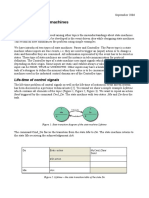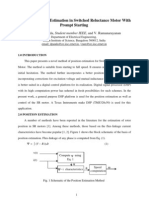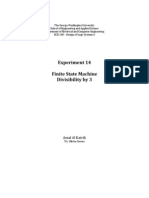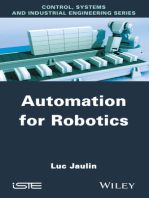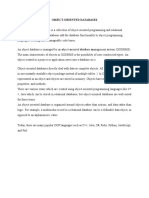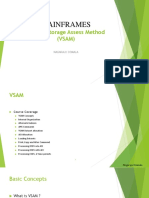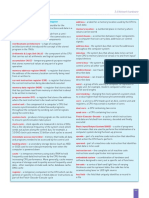Finite State Machines: Finite State Machine Next-State Function
Finite State Machines: Finite State Machine Next-State Function
Uploaded by
Anish MathewOriginal Description:
Original Title
Copyright
Available Formats
Share this document
Did you find this document useful?
Is this content inappropriate?
Report this DocumentCopyright:
Available Formats
Finite State Machines: Finite State Machine Next-State Function
Finite State Machines: Finite State Machine Next-State Function
Uploaded by
Anish MathewCopyright:
Available Formats
B.
10
Finite State Machines
B-67
128-bit word needs 8. This type of code is called a Hamming code, after R. Hamming, who described a method for creating such codes.
B.10
Finite State Machines
B.10
As we saw earlier, digital logic systems can be classied as combinational or sequential. Sequential systems contain state stored in memory elements internal to the system. Their behavior depends both on the set of inputs supplied and on the contents of the internal memory, or state of the system. Thus, a sequential system cannot be described with a truth table. Instead, a sequential system is described as a nite state machine (or often just state machine). A nite state machine has a set of states and two functions called the next-state function and the output function. The set of states correspond to all the possible values of the internal storage. Thus, if there are n bits of storage, there are 2n states. The nextstate function is a combinational function that, given the inputs and the current state, determines the next state of the system. The output function produces a set of outputs from the current state and the inputs. Figure B.10.1 shows this diagrammatically.
nite state machine A sequential logic function consisting of a set of inputs and outputs, a next-state function that maps the current state and the inputs to a new state, and an output function that maps the current state and possibly the inputs to a set of asserted outputs. next-state function A combinational function that, given the inputs and the current state, determines the next state of a finite state machine.
Next state Current state Next-state function
Clock Inputs
Output function
Outputs
FIGURE B.10.1 A state machine consists of internal storage that contains the state and two combinational functions: the next-state function and the output function. Often, the output function is restricted to take only the current state as its input; this does not change the capability of a sequential machine, but does affect its internals.
B-68
Appendix B
The Basics of Logic Design
The state machines we discuss here and in Chapters 5 and 6 are synchronous. This means that the state changes together with the clock cycle, and a new state is computed once every clock. Thus, the state elements are updated only on the clock edge. We use this methodology in this section and throughout Chapters 5 and 6, and we do not usually show the clock explicitly. We use state machines throughout Chapters 5 and 6 to control the execution of the processor and the actions of the datapath. To illustrate how a nite state machine operates and is designed, lets look at a simple and classic example: controlling a trafc light. (Chapters 5 and 6 contain more detailed examples of using nite state machines to control processor execution.) When a nite state machine is used as a controller, the output function is often restricted to depend on just the current state. Such a nite state machine is called a Moore machine. This is the type of nite state machine we use throughout this book. If the output function can depend on both the current state and the current input, the machine is called a Mealy machine. These two machines are equivalent in their capabilities, and one can be turned into the other mechanically. The basic advantage of a Moore machine is that it can be faster, while a Mealy machine may be smaller, since it may need fewer states than a Moore machine. In Chapter 5, we discuss the differences in more detail and show a Verilog version of nite state control using a Mealy machine. Our example concerns the control of a trafc light at an intersection of a northsouth route and an east-west route. For simplicity, we will consider only the green and red lights; adding the yellow light is left for an exercise. We want the lights to cycle no faster than 30 seconds in each direction, so we will use a 0.033 Hz clock so that the machine cycles between states at no faster than once every 30 seconds. There are two output signals:
NSlite: When this signal is asserted, the light on the north-south road is green; when this signal is deasserted the light on the north-south road is red. EWlite: When this signal is asserted, the light on the east-west road is green; when this signal is deasserted the light on the east-west road is red. NScar: Indicates that a car is over the detector placed in the roadbed in front of the light on the north-south road (going north or south). EWcar: Indicates that a car is over the detector placed in the roadbed in front of the light on the east-west road (going east or west).
In addition, there are two inputs: NScar and EWcar.
The trafc light should change from one direction to the other only if a car is waiting to go in the other direction; otherwise, the light should continue to show green in the same direction as the last car that crossed the intersection.
B.10
Finite State Machines
B-69
To implement this simple trafc light we need two states:
NSgreen: The trafc light is green in the north-south direction. EWgreen: The trafc light is green in the east-west direction.
We also need to create the next-state function, which can be specied with a table:
Inputs Current state
NSgreen NSgreen NSgreen NSgreen EWgreen EWgreen EWgreen EWgreen
NScar
0 0 1 1 0 0 1 1
EWcar
0 1 0 1 0 1 0 1
Next state
NSgreen EWgreen NSgreen EWgreen EWgreen EWgreen NSgreen NSgreen
Notice that we didnt specify in the algorithm what happens when a car approaches from both directions. In this case, the next-state function given above changes the state to ensure that a steady stream of cars from one direction cannot lock out a car in the other direction. The nite state machine is completed by specifying the output function:
Outputs Current state
NSgreen EWgreen
NSlite
1 0
EWlite
0 1
Before we examine how to implement this nite state machine, lets look at a graphical representation, which is often used for nite state machines. In this representation, nodes are used to indicate states. Inside the node we place a list of the outputs that are active for that state. Directed arcs are used to show the next-state function, with labels on the arcs specifying the input condition as logic functions. Figure B.10.2 shows the graphical representation for this nite state machine. A nite state machine can be implemented with a register to hold the current state and a block of combinational logic that computes the next-state function and the output function. Figure B.10.3 shows how a nite state machine with 4 bits of state, and thus up to 16 states, might look. To implement the nite state machine in this way, we must rst assign state numbers to the states. This process is called state assignment. For example, we could assign NSgreen to state 0 and
B-70
Appendix B
The Basics of Logic Design
EWcar
NSgreen NScar NSlite EWlite
EWgreen
EWca
NScar
FIGURE B.10.2 The graphical representation of the two-state trafc light controller. We simplied the logic functions on the state transitions. For example, the transition from NSgreen to EWgreen in the next-state table is ( NScar EWcar ) + ( NScar EWcar ), which is equivalent to EWcar.
EWgreen to state 1. The state register would contain a single bit. The next-state function would be given as NextState = ( CurrentState EWcar ) + ( CurrentState NScar ) where CurrentState is the contents of the state register (0 or 1) and NextState is the output of the next-state function that will be written into the state register at the end of the clock cycle. The output function is also simple: NSlite = CurrentState EWlite = CurrentState The combinational logic block is often implemented using structured logic, such as a PLA. A PLA can be constructed automatically from the next-state and output function tables. In fact, there are computer-aided design (CAD) programs that take either a graphical or textual representation of a nite state machine and produce an optimized implementation automatically. In Chapters 5 and 6, nite state machines were used to control processor execution. Appendix C discusses the detailed implementation of these controllers with both PLAs and ROMs. To show how we might write the control in Verilog, Figure B.10.4 shows a Verilog version designed for synthesis. Note that for this simple control function, a Mealy machine is not useful, but this style of specication is used in Chapter 5 to implement a control function that is a Mealy machine and has fewer states than the Moore machine controller.
B.10
Finite State Machines
B-71
Outputs Combinational logic
Next state
State register
Inputs FIGURE B.10.3 A nite state machine is implemented with a state register that holds the current state and a combinational logic block to compute the next state and output functions. The latter two functions are often split apart and implemented with two separate blocks of logic, which may require fewer gates.
module TrafficLite (EWCar,NSCar,EWLite,NSLite,clock); input EWCar, NSCar,clock; output EWLite,NSLite; reg state; initial state=0; //set initial state
//following two assignments set the output, which is based only on the state variable assign NSLite = ~ state; //NSLite on if state = 0; assign EWLite = state; //EWLite on if state =1 always @(posedge clock) // all state updates on a positive clock edge case (state) 0: state = EWCar; //change state only if EWCar 1: state = NSCar; //change state only if NSCar endcase endmodule
FIGURE B.10.4 A Verilog version of the trafc light controller.
You might also like
- Pid Without A PHD PDFDocument14 pagesPid Without A PHD PDFGiovanni Eliezer100% (2)
- Finite State MachineDocument11 pagesFinite State MachineMohammad SalmanNo ratings yet
- EXP3Document10 pagesEXP3pilawak670No ratings yet
- DLD Term ProjectDocument10 pagesDLD Term ProjectH052 Rajesh Komaravalli ECENo ratings yet
- We Know That Synchronous Sequential Circuits ChangeDocument7 pagesWe Know That Synchronous Sequential Circuits ChangeMario MonaNo ratings yet
- 11.1 Introduction To State Machines: Chapter ElevenDocument24 pages11.1 Introduction To State Machines: Chapter ElevenReham MuzzamilNo ratings yet
- Design of An Antenna Azimuth Position Control SystemDocument12 pagesDesign of An Antenna Azimuth Position Control SystemUche PaulNo ratings yet
- Project 3: Software Based Finite State MachinesDocument13 pagesProject 3: Software Based Finite State MachineselvagojpNo ratings yet
- Module 11-Design of Synchronous Sequential Counters and State MachinesDocument6 pagesModule 11-Design of Synchronous Sequential Counters and State MachinesRodrigoBrianMamaniNo ratings yet
- Self Balancing Two Wheeled Robot ReportDocument11 pagesSelf Balancing Two Wheeled Robot Reportnetlvr0No ratings yet
- Unit - 1 DSDDocument56 pagesUnit - 1 DSDultimatekp144No ratings yet
- Automatic Generation ControlDocument5 pagesAutomatic Generation ControlMuhammad Nizamuddin100% (2)
- Event Driven State MachinesDocument5 pagesEvent Driven State Machinesyewie561No ratings yet
- Acs 2017s1 Assn1Document5 pagesAcs 2017s1 Assn1MiraelNo ratings yet
- Week 12 - Module 10 Finite State Machines 1Document7 pagesWeek 12 - Module 10 Finite State Machines 1Ben GwenNo ratings yet
- Accurate Position Estimation in Switched Reluctance Motor With Prompt StartingDocument10 pagesAccurate Position Estimation in Switched Reluctance Motor With Prompt Startingmounicapaluru_351524No ratings yet
- Beckhoff TwincatDocument15 pagesBeckhoff TwincatKishore KumarNo ratings yet
- Chapter # 3, INSIDE DIGITAL DESIGNDocument29 pagesChapter # 3, INSIDE DIGITAL DESIGNCh M AamirNo ratings yet
- Antenna AzimuthDocument6 pagesAntenna AzimuthDavePascualNo ratings yet
- How To Design A Finite State Machine Sequence DetectorDocument14 pagesHow To Design A Finite State Machine Sequence Detectorzlh14188No ratings yet
- Lecture 11Document21 pagesLecture 11fotescuiondaniel7No ratings yet
- Tutorial 5Document31 pagesTutorial 5Sathish KumarNo ratings yet
- Ise VHDL State Machine Process NEXYS3 SOEDocument14 pagesIse VHDL State Machine Process NEXYS3 SOEmdzakir_hussainNo ratings yet
- State Machine DesignDocument20 pagesState Machine DesignAnonymous pHi4dXNo ratings yet
- Control Project ModifiedDocument4 pagesControl Project ModifiedMohamed Elsayed HasanNo ratings yet
- Mealy and Moore Type Finite State MachinesDocument9 pagesMealy and Moore Type Finite State MachinesNithyendra RoyNo ratings yet
- DC MotorDocument6 pagesDC MotorKumaran SgNo ratings yet
- Capstone ResearchProject Moore Mealy MachineDocument9 pagesCapstone ResearchProject Moore Mealy MachineAnish ChatterjeeNo ratings yet
- ASM2Document8 pagesASM2Sri LathaNo ratings yet
- Pole Placement by State Feedback in DC Motor by MatlabDocument13 pagesPole Placement by State Feedback in DC Motor by MatlabJason JonesNo ratings yet
- c108 - WWW - Matlabi.ir - DC Motor Position Control Using State Space TechniqueDocument6 pagesc108 - WWW - Matlabi.ir - DC Motor Position Control Using State Space TechniqueMuhammad Ahsan AyubNo ratings yet
- Lab 14Document11 pagesLab 14amalkatribNo ratings yet
- State Machine Present State: A0-Ak-1 Inputs Outputs B0-Bm-1Document4 pagesState Machine Present State: A0-Ak-1 Inputs Outputs B0-Bm-1Fatmir KelmendiNo ratings yet
- Ijert Ijert: Control of Three Phase BLDC Motor Using Fuzzy Logic ControllerDocument5 pagesIjert Ijert: Control of Three Phase BLDC Motor Using Fuzzy Logic ControllergbksnNo ratings yet
- Assignment Continuous SysDocument13 pagesAssignment Continuous SysMohamed Elsayed HarbNo ratings yet
- Digital Circuits - Finite State MachinesDocument3 pagesDigital Circuits - Finite State Machinesyasar saleemNo ratings yet
- VHDL FSM UNIT 5 ET&T 7th SemDocument22 pagesVHDL FSM UNIT 5 ET&T 7th SemDEEPA KUNWARNo ratings yet
- Driver Motor BrushlesDocument48 pagesDriver Motor BrushlesGONAJ2008No ratings yet
- Finite State MachinesDocument55 pagesFinite State Machinesdeepanilsaxena100% (2)
- Chapter 2 Hardware and Software Design IssuesDocument12 pagesChapter 2 Hardware and Software Design IssuespurushresthaNo ratings yet
- 2092-At001 - En-P Ab Simple Motion Control PLC BasedDocument5 pages2092-At001 - En-P Ab Simple Motion Control PLC BasedCristopher EntenaNo ratings yet
- Beckhoff El5021Document40 pagesBeckhoff El5021Nagarajan RajaNo ratings yet
- Chapter #8: Finite State Machine DesignDocument57 pagesChapter #8: Finite State Machine DesignAli AhmadNo ratings yet
- DC Motor Speed ModelingDocument4 pagesDC Motor Speed ModelingAvinash TrivediNo ratings yet
- Chiranjeevi.G. Udnoor VTU: 3PD09EC403 Q No.8: Sequential LogicDocument6 pagesChiranjeevi.G. Udnoor VTU: 3PD09EC403 Q No.8: Sequential LogicPrashant DagaNo ratings yet
- Speed Control of DC Motor Using PSO TuneDocument5 pagesSpeed Control of DC Motor Using PSO TunegadaNo ratings yet
- Finite State Machines: Moore MachineDocument4 pagesFinite State Machines: Moore Machineborakas_borakasNo ratings yet
- Ce G 3150 Lab 4 Traffic LightDocument22 pagesCe G 3150 Lab 4 Traffic LightAli AhmadNo ratings yet
- PLC S Basicos GE Fanuc Jr.Document29 pagesPLC S Basicos GE Fanuc Jr.Juvenal G. C. GallardoNo ratings yet
- EE 552 (Logic Design and Switching Theory) Project: Quantitative Measurement of The Benefits of Reduction Techniques For Asynchronous Finite State MachinesDocument9 pagesEE 552 (Logic Design and Switching Theory) Project: Quantitative Measurement of The Benefits of Reduction Techniques For Asynchronous Finite State MachinesTamiltamil TamilNo ratings yet
- Simplified Sensorless Control For BLDC MDocument12 pagesSimplified Sensorless Control For BLDC MAlg DimasNo ratings yet
- Direct Torque Control of Induction MotorsDocument6 pagesDirect Torque Control of Induction MotorsInternational Journal of Application or Innovation in Engineering & ManagementNo ratings yet
- AGC 1 (Chapter 11) : NERC Penalties For Poor-Performance (CPS) Load Performance Can Be Frequency-DependentDocument28 pagesAGC 1 (Chapter 11) : NERC Penalties For Poor-Performance (CPS) Load Performance Can Be Frequency-DependentFengxing Zhu100% (1)
- Investigation of the Usefulness of the PowerWorld Simulator Program: Developed by "Glover, Overbye & Sarma" in the Solution of Power System ProblemsFrom EverandInvestigation of the Usefulness of the PowerWorld Simulator Program: Developed by "Glover, Overbye & Sarma" in the Solution of Power System ProblemsNo ratings yet
- Simulation of Some Power System, Control System and Power Electronics Case Studies Using Matlab and PowerWorld SimulatorFrom EverandSimulation of Some Power System, Control System and Power Electronics Case Studies Using Matlab and PowerWorld SimulatorNo ratings yet
- Advanced Techniques and Technology of Computer-Aided Feedback ControlFrom EverandAdvanced Techniques and Technology of Computer-Aided Feedback ControlNo ratings yet
- Control of DC Motor Using Different Control StrategiesFrom EverandControl of DC Motor Using Different Control StrategiesNo ratings yet
- DCIT 21reviewerDocument3 pagesDCIT 21reviewerRue LeeNo ratings yet
- Q24 LTO Library KitsDocument2 pagesQ24 LTO Library Kitsmana45No ratings yet
- Computer Hardware Servicing NC II Assesment Free ReviewerDocument6 pagesComputer Hardware Servicing NC II Assesment Free ReviewerMarnel Matunog IwamotoNo ratings yet
- OBJECT Oriented DatabasesDocument7 pagesOBJECT Oriented DatabasesMaina GeorgeNo ratings yet
- M Tech Q BankDocument89 pagesM Tech Q BankVamos VamsiNo ratings yet
- Assessment Review - Dell Inc - D-ISM-FN-23-attempt1Document4 pagesAssessment Review - Dell Inc - D-ISM-FN-23-attempt1Christos ChatzigeorgiouNo ratings yet
- FCS Assignment 3: Etash Tyagi 2019360 December 2021Document13 pagesFCS Assignment 3: Etash Tyagi 2019360 December 2021ONE EYED KINGNo ratings yet
- Freescale-HCS12 - S12X-S12P-MC9S12P128-Learning Centre MCU-Application Notes-Freescale - Application - Notes - 1Document14 pagesFreescale-HCS12 - S12X-S12P-MC9S12P128-Learning Centre MCU-Application Notes-Freescale - Application - Notes - 1Phạm QuangNo ratings yet
- NetApp Snap Manager For Oracle TutorialDocument15 pagesNetApp Snap Manager For Oracle TutorialRajesh YeletiNo ratings yet
- 6.828 Fall 2012 Lab 2: Memory Management: Getting StartedDocument8 pages6.828 Fall 2012 Lab 2: Memory Management: Getting StartedAhmed fattoumNo ratings yet
- Operating System ExtraDocument109 pagesOperating System Extrahaideraliapp76No ratings yet
- Introduction To DBMSDocument28 pagesIntroduction To DBMSapi-19922433No ratings yet
- VSAMDocument94 pagesVSAMNagfaceNo ratings yet
- Hardware GlossaryDocument3 pagesHardware GlossaryAtifa OmerNo ratings yet
- BP 2009 Metro Availability PDFDocument66 pagesBP 2009 Metro Availability PDFEduardo LoureiroNo ratings yet
- System Requirements Autodesk Revit 2024Document8 pagesSystem Requirements Autodesk Revit 2024Alemat RedaeNo ratings yet
- CSS Module Q3Document60 pagesCSS Module Q3hi022885No ratings yet
- Install Lsof On Solaris11Document4 pagesInstall Lsof On Solaris11ramkamalakkannanNo ratings yet
- Question Paper Computer FundamentalsDocument5 pagesQuestion Paper Computer Fundamentalsshivscribd1100% (1)
- COMPUTER SYLLABUS o Level For UgandaDocument10 pagesCOMPUTER SYLLABUS o Level For UgandaJoram Bwambale100% (1)
- Database Presentation SlidesDocument52 pagesDatabase Presentation Slidestanyah LloydNo ratings yet
- Accelerate With IBM Storage: Data Reduction Pool (DRP) Overview/Best PracticesDocument49 pagesAccelerate With IBM Storage: Data Reduction Pool (DRP) Overview/Best Practicesjalvarez82No ratings yet
- 24 C 04Document15 pages24 C 04roberto caiadoNo ratings yet
- CDC 3000 SeriesDocument14 pagesCDC 3000 Seriesjriva126No ratings yet
- Week 9 - Tools in Multimedia and Web TechnologyDocument43 pagesWeek 9 - Tools in Multimedia and Web Technologyc23a0876No ratings yet
- M12H 2SD MDVR Manual (V1.1)Document34 pagesM12H 2SD MDVR Manual (V1.1)nandutiNo ratings yet
- 1.1.3 Syllabus B. Tech (CS) 2015-16Document117 pages1.1.3 Syllabus B. Tech (CS) 2015-16SHARAN SASINo ratings yet
- Vsphere Esxi Vcenter Server 672 Monitoring Performance GuideDocument233 pagesVsphere Esxi Vcenter Server 672 Monitoring Performance GuideAnonymous N22tyB6UNNo ratings yet
- Bhagavatula CV Jan2010Document48 pagesBhagavatula CV Jan2010Aman ChadhaNo ratings yet
- Synectics PSN ProDocument2 pagesSynectics PSN Prosyedpandt100% (1)












